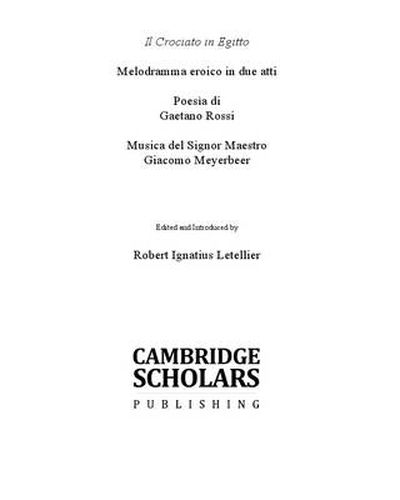Readings Newsletter
Become a Readings Member to make your shopping experience even easier.
Sign in or sign up for free!
You’re not far away from qualifying for FREE standard shipping within Australia
You’ve qualified for FREE standard shipping within Australia
The cart is loading…






This book reproduces the Ricordi vocal score of Meyerbeer’s last Italian opera (Milan, c. 1825). More than hardly any other opera of the first third of the nineteenth century, Il Crociato in Egitto (Venice, 1814) appears as work standing between the epochs. In its engagement with the traditions of the melodramma, Meyerbeer exploited here to the full all the possibilities offered by the form, without actually questioning its nature. Whereas Rossini in his Neapolitan operas had undertaken a transformation of the genre, moving it in the direction of French grand opera, Meyerbeer on the one hand continued a heightened development of the generic tendencies, while on the other affecting a deliberate resumption of older forms, already obsolete at this time (like simple romance structures and the use of recitativo secco, especially to mark the closure of scenes). The disparate medium of presentation spans isolated individual numbers and highly integrated tableaux of solo and chorus, traditional lyrical virtuosity and the dramaturgy of modern instrumental colour, melodic models from the eighteenth century, and anticipation of middle Verdi, integrated only by the strongly imprinted force of the individual style. Even more than in Margherita d'Anjou and L'Esule di Granata, the Crociato opens up to the historical opera. The personal conflict still determines the dramaturgy, but this is projected onto historical circumstances and given a philosophical component through the figure of the religious fanatic Adriano. Throughout the whole opera, the antagonism between the Crusaders and the Egyptians, until their final magnanimous reconciliation, is depicted in contrasting dramatic terms as the confrontation between two cultures and religions. The formal structures for such a dramaturgy also shapes the tableaux in this opera.
$9.00 standard shipping within Australia
FREE standard shipping within Australia for orders over $100.00
Express & International shipping calculated at checkout
This book reproduces the Ricordi vocal score of Meyerbeer’s last Italian opera (Milan, c. 1825). More than hardly any other opera of the first third of the nineteenth century, Il Crociato in Egitto (Venice, 1814) appears as work standing between the epochs. In its engagement with the traditions of the melodramma, Meyerbeer exploited here to the full all the possibilities offered by the form, without actually questioning its nature. Whereas Rossini in his Neapolitan operas had undertaken a transformation of the genre, moving it in the direction of French grand opera, Meyerbeer on the one hand continued a heightened development of the generic tendencies, while on the other affecting a deliberate resumption of older forms, already obsolete at this time (like simple romance structures and the use of recitativo secco, especially to mark the closure of scenes). The disparate medium of presentation spans isolated individual numbers and highly integrated tableaux of solo and chorus, traditional lyrical virtuosity and the dramaturgy of modern instrumental colour, melodic models from the eighteenth century, and anticipation of middle Verdi, integrated only by the strongly imprinted force of the individual style. Even more than in Margherita d'Anjou and L'Esule di Granata, the Crociato opens up to the historical opera. The personal conflict still determines the dramaturgy, but this is projected onto historical circumstances and given a philosophical component through the figure of the religious fanatic Adriano. Throughout the whole opera, the antagonism between the Crusaders and the Egyptians, until their final magnanimous reconciliation, is depicted in contrasting dramatic terms as the confrontation between two cultures and religions. The formal structures for such a dramaturgy also shapes the tableaux in this opera.